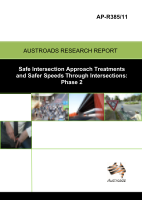Road Design

Safe Intersection Approach Treatments and Safer Speeds Through Intersections: Phase 2
- Publication no: AP-R385-11
- ISBN: 978-1-921709-91-3
- Published: 26 August 2011
- PDF (free) Download
This project examines speeds through intersections. Phase 2 provides an assessment of selected treatments at intersections. A key objective of this research is to provide information to Austroads members on effective techniques to reduce speed and speed-related crashes at intersections. These will be assessed in light of the Safe System approach, particularly with regard to harm minimisation in speed management.
- 1. INTRODUCTION
- 2. PROJECT OUTLINE
- 2.1. Safe Intersection Speeds – Overview
- 2.2. Outcomes from Phase 1
- 2.3. Objectives for Phase 2
- 2.4. Report Scope
- 3. PHASE 2 – CASE STUDIES
- 3.1. Method
- 3.1.1. Case Study Examples
- 3.1.2. Analysis
- 3.2. Case Study Details
- 3.2.1. Examples from Road Authorities
- 3.2.2. Scope of Treatments
- 3.2.3. Documentation
- 3.2.4. Data Issues
- 4. FINDINGS FROM CASE STUDIES
- 4.1. Treatment Types
- 4.2. Indications of Effectiveness
- 4.2.1. Roundabouts
- 4.2.2. Reduced Speed Limit
- 4.2.3. Vehicle Activated Signs
- 4.2.4. Vertical Deflection
- 4.2.5. Horizontal Deflection
- 4.2.6. Transverse Pavement Devices
- 4.2.7. Other Devices and Treatments
- 4.3. Summary of Findings
- 5. DISCUSSION
- 5.1. Reducing Speeds at Intersections
- 5.2. Implications for Treatments
- 5.2.1. Advance Warning
- 5.2.2. Combined Treatments
- 5.3. Implications for Evaluation
- 5.3.1. Evaluation Design
- 5.3.2. Multiple Treatments
- 5.3.3. Speed Profiles
- 6. CONCLUSION
- 6.1. Intersection Speed Reduction Treatments
- 6.2. Recommendations
- 6.2.1. Treatments
- 6.2.2. Evaluation
- REFERENCES
- APPENDIX A CASE STUDY DETAILS
- APPENDIX B CASE STUDY OBSERVATIONS SUMMARY
Related publications
AP-R700-23
Latest Road Design News
